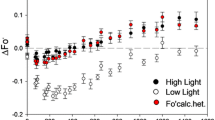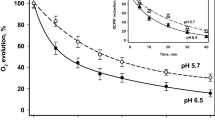Abstract
Photosystem II complexes of higher plants are structurally and functionally heterogeneous. While the only clearly defined structural difference is that Photosystem II reaction centers are served by two distinct antenna sizes, several types of functional heterogeneity have been demonstrated. Among these is the observation that in dark-adapted leaves of spinach and pea, over 30% of the Photosystem II reaction centers are unable to reduce plastoquinone to plastoquinol at physiologically meaningful rates. Several lines of evidence show that the impaired reaction centers are effectively inactive, because the rate of oxidation of the primary quinone acceptor, QA, is 1000 times slower than in normally active reaction centers. However, there are conflicting opinions and data over whether inactive Photosystem II complexes are capable of oxidizing water in the presence of certain artificial electron acceptors. In the present study we investigated whether inactive Photosystem II complexes have a functional water oxidizing system in spinach thylakoid membranes by measuring the flash yield of water oxidation products as a function of flash intensity. At low flash energies (less that 10% saturation), selected to minimize double turnovers of reaction centers, we found that in the presence of the artificial quinone acceptor, dichlorobenzoquinone (DCBQ), the yield of proton release was enhanced 20±2% over that observed in the presence of dimethylbenzoquinone (DMBQ). We argue that the extra proton release is from the normally inactive Photosystem II reaction centers that have been activated in the presence of DCBQ, demonstrating their capacity to oxidize water in repetitive flashes, as concluded by Graan and Ort (Biochim Biophys Acta (1986) 852: 320–330). The light saturation curves indicate that the effective antenna size of inactive reaction centers is 55±12% the size of active Photosystem II centers. Comparison of the light saturation dependence of steady state oxygen evolution in the presence of DCBQ or DMBQ support the conclusion that inactive Photosystem II complexes have a functional water oxidation system.
Similar content being viewed by others
Abbreviations
- DCBQ:
-
2,6-dichloro-p-benzoquinone
- DMBQ:
-
2,5-dimethyl-p-benzoquinone
- Fo :
-
initial fluorescence level using dark-adapted thylakoids
- Inactive reaction centers:
-
reaction centers inactive in plastoquinone reduction
- PS II:
-
Photosystem II
- QA :
-
primary quinone acceptor of Photosystem II
- QB :
-
secondary quinone acceptor of Photosystem II
References
Cao J. and Govindjee (1990) Chlorophyll a fluorescence as an indicator of inactive Photosystem II in thylakoid membranes. Biochim Biophys Acta 1015: 180–188
Chylla RA Garab G and Whitmarsh J (1987) Evidence for slow turnover in a fraction of Photosystem II complexes in thylakoid membranes. Biochim Biophys Acta 894: 562–571
Chylla RA and Whitmarsh J (1989) Inactive Photosystem II complexes in leaves. Turnover rate and quantitation. Plant Physiol 90: 765–772
Chylla RA and Whitmarsh J (1990) Light saturation response of inactive Photosystem II reaction centers in spinach. Photosynth Res 25: 39–48
Graan T and Ort DR (1986) Detection of oxygen-evolving Photosystem II centers inactive in plastoquinone reduction. Biochim Biophys Acta 852: 320–330
Guenther JE and Melis A (1990) The physiological significance of Photosystem II heterogeneity in chloroplasts. Photosynth Res 23: 105–109
Hansson O and Wydryznski T (1990) Current perceptions of Photosystem II. Photosynth Res 23: 131–162
Henrysson T and Sundby C (1990) Characterization of Photosystem II in stroma thylakoid membranes. Photosynth Res 25: 107–117
Hsu B-D and Lee J-Y (1991) Characterization of the Photosystem II centers inactive in plastoquinone reduction by fluorescence induction. Photosynth Res 27: 143–150
Jursinic PA and Dennenberg RJ (1988) Enhanced oxygen yields caused by double turnovers of Photosystem II induced by dichlorobenzoquinone. Biochim Biophys Acta 934: 177–185
Lavergne J (1982a) Two types of primary acceptor in chloroplasts Photosystem II. I. Different recombination properties. Photobiochem Photobiophys 3: 257–271
Lavergne J (1982b) Two types of primary acceptor in chloroplasts Photosystem II. II. Reduction in two successive photoacts. Photobiochem Photobiophys 3: 257–271
Lee W-J and Whitmarsh J (1989) Photosynthetic apparatus of pea thylakoid membranes. Response to growth light intensity. Plant Physiol 89: 932–940
Ley AC and Mauzerall DC (1986) The extent of energy transfer among Photosystem II reaction centers in Chlorella. Biochim Biophys Acta 850: 234–248
Mauzerall D and Greenbaum NL (1989) The absolute size of a photosynthetic unit. Biochim Biophys Acta 974: 119–140
Melis A (1985) Functional properties of PS IIβ in spinach chloroplasts. Biochim Biophys Acta 808: 334–342
Neale PJ and Melis A (1990) Activation of a reserve pool of Photosystem II in Chlamydomonas reinhardtii counteracts photoinhibition. Plant Physiol 92: 1196–1204
Nedbal L and Whitmarsh J (1991) Photosystem II reaction centers inactive in plastoquinone reduction: A brief overview. Photosynthetica, Submitted for publication
Ort DR and Whitmarsh J (1990) Inactive Photosystem II reaction centers: A resolution of discrepancies in Photosystem II quantitation? Photosynth Res 23: 101–104
Petrouleas V and Diner BA (1987) Light-induced oxidation of the acceptor-side Fe(II) of Photosystem II by exogenous quinones acting through the QB binding site. I. Quinones, kinetics and pH dependence. Biochim Biophys Acta 893: 126–137
Rees D and Horton P (1990) The mechanisms of changes in Photosystem II efficiency in spinach thylakoids. Biochim Biophys Acta 1016: 219–227
Tyystjärvi E and Aro E-M (1990) Temperature-dependent changes in Photosystem II heterogeneity support a cycle of Photosystem II during photoinhibition. Photosynth Res 26: 109–117
Whitmarsh J and Chylla R (1990) Hypothesis: In leaves inactive PS II complexes are converted during illumination to an active form that drives an electron cycle and quenches fluorescence. Plant Physiol 93: 142
Whitmarsh J and Ort DR (1984) Stoichiometries of electron transport complexes in spinach chloroplasts. Arch Biochem Biophys 231: 378–389
Ziegler R and Egle K (1965) Zur quantitativen Analyse Chloroplastenpigmente. Kritische Überprüfung der spektralphotometrischen Chlorophyll-Bestimmung. Beitr Biol Pflanzen 41: 11–37
Zimmermann J-L and Rutherford AW (1986) Photoreductant-induced oxidation of Fe2+ in the electron-acceptor complex of Photosystem II. Biochim Biophys Acta 851: 416–423
Author information
Authors and Affiliations
Additional information
Department of Plant Biology, University of Illinois
Department of Physiology & Biophysics, University of Illinois
Rights and permissions
About this article
Cite this article
Nedbal, L., Gibas, C. & Whitmarsh, J. Light saturation curves show competence of the water splitting complex in inactive Photosystem II reaction centers. Photosynth Res 30, 85–94 (1991). https://doi.org/10.1007/BF00042006
Received:
Accepted:
Issue Date:
DOI: https://doi.org/10.1007/BF00042006




